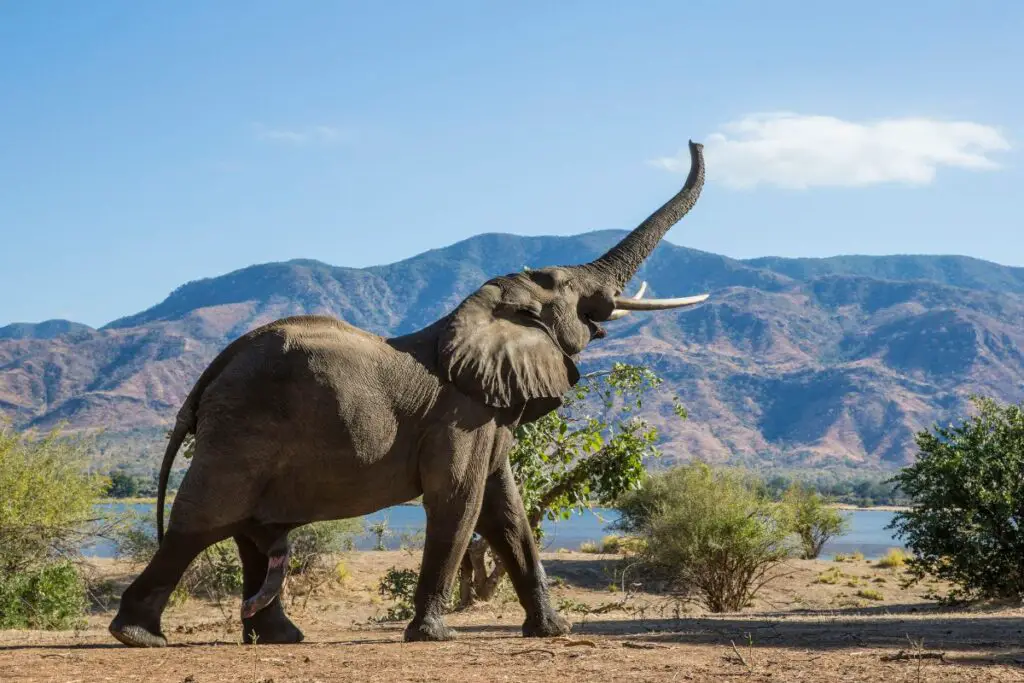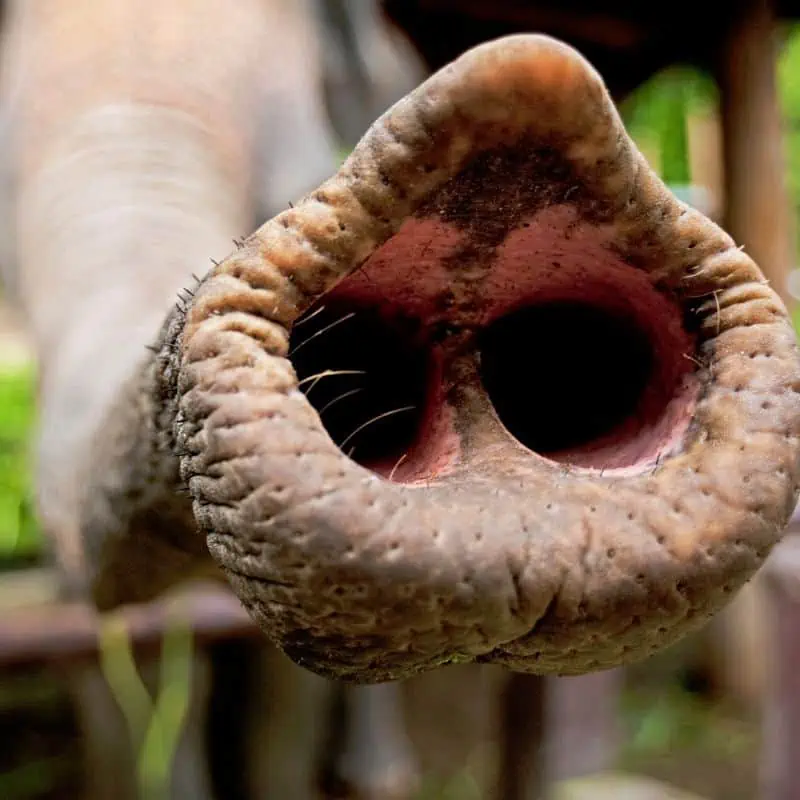The incredible sense of smell that elephants possess is nothing short of remarkable. Elephants can detect scents from miles away, using their trunk to sample the air to identify potential dangers and threats. But how exactly do these magnificent creatures utilize their sensitive olfactory organs?
Elephants smell using their trunks. Just like humans, they have two nostrils on their trunks. However, their ability to smell from afar is far better than humans. They can even smell water from miles away. Additionally, Elephants have the largest number of olfactory receptors among all the animals on the planet. So, that becomes an essential asset for their smelling power.
In this article, we’ll break this down further and examine the incredible smelling powers elephants possess.

Insight Into An Elephant’s Nose
No other animal on earth has a long trunk for a nose. That’s what makes elephants unique and helps them out-sniff other mammals.
To understand why elephants have a better sense of smell than other animals, you should know the anatomy of an elephant’s trunk.
Let’s take an insight into an elephant’s nose.
Anatomy of an Elephant’s Nose
Elephants have long trunks with a pair of nostrils on the tip. Their upper nasal cavity has a giant olfactory bulb and several olfactory receptors.
An olfactory bulb is a neural structure located in the forebrain of all animals. It has many cells responsible for catching scent particles and relaying them to the brain, helping perceive different smells. Like any other mammal, elephants have two such olfactory bulbs.
One is the Main Olfactory Bulb (MOB), and the other is Accessory Olfactory Bulb.
There is no morphological difference in an olfactory bulb of an elephant as compared to other animals. Only the huge size of elephants’ MOB makes them stand out among animals with a strong sense of smell.

Role of Olfactory Genes
Elephants’ sniffing ability has stunned even the most expert geneticists. Meaning olfactory genes have a huge role in improving elephants’ sense of smell.
Scientists have discovered more than 2000 genes in elephants solely responsible for olfaction. To give you an idea for comparison, humans have around 400 genes encoding their sense of smell. That’s a big difference!
These genes in elephants encode more olfactory cells than in humans and other animals. Hence, more cells equal a stronger ability to smell.
What Role Does the Trunk Play?
An elephant’s trunk is truly a mysterious structure. It helps elephants breathe, feed, fight, store gallons of water, produce noises, and, most importantly, smell things from miles away.
Elephants can move their trunk back and forth, catching the nearby molecules that pass through their trunks into the large olfactory bulb. These molecules then travel through seven olfactory turbinals with millions of smell-sensing receptors.
Similarly, elephants have another organ if they can’t detect the surrounding molecules. They then ‘collect’ or ‘suck’ these substances using their nostrils and relay them to Jacobson’s organ in an elephant’s mouth.
Male elephants mostly use this method during the reproductive period to perceive the chemical signals of a female elephant.
That is how the trunk detects new smells and information from surroundings.
How Strong is an Elephant’s Sense of Smell?
Research suggests elephants can smell water from 19.2 km or 12 miles. Experiments were performed to see the strength of elephants’ sense of smell.
It was discovered that elephants could easily differentiate between two flowers with the same scent. That’s magical!
Moreover, studies have proven the trunk’s ability to detect TNT. Elephants can even differentiate between human tribes, those that were bad, from those that have treated them well.
Furthermore, they can also tell the quantity of a particular substance using their powerful sense of smell. That was proven by experimenting with different amounts of sunflower seeds in separate buckets. As expected, the elephants didn’t disappoint.
Sense of Smell: Elephant vs. Other Animals
Here are two common comparisons to get a better idea of how superior an elephant’s sense of smell is.
Elephant’s vs. Dog’s Sense of Smell
We have all heard about bloodhounds. They are famous for detecting smell from a distance and have been a helping hand in many investigations.
Elephants have even out-sniffed these dogs with their superior sniffing abilities. They have more than twice the olfactory genes of dogs. As mentioned earlier, elephants have 2000 olfactory genes, whereas dogs have only around 800.

Elephant’s vs. Human’s Sense of Smell
Compared to elephants, humans have fewer olfactory receptors and genes. Therefore, their sense of smell is far less than elephants and even dogs.
Humans have around 400 olfactory genes, five times fewer than elephants; hence, humans don’t stand a chance in competing against elephants.
Moreover, Jacobson’s organ is now a long-forgotten vestigial organ in humans, whereas elephants still hold onto it. And lastly, as we said earlier, elephants can smell water, and humans have no superpower.
Final Thoughts On How Elephants Smell
Elephants use the two nostrils like any other animal to smell substances. Their trunk helps them pick substances from their surroundings and detect a change in smell.
Elephants are unique in their ability to smell things due to a higher number of olfactory genes and a huge-sized olfactory bulb.
FAQs
How Far Can Elephants Smell?
Elephants have a powerful sense of smell owing to their extra genes and big olfactory bulb. They can smell water from 12 miles away, as said earlier. They can even sense danger and alert the herd. Elephants can also follow a trail of the leader elephant using their smelling skills.
Can Elephants Replace Detection Dogs?
It’s a no-brainer now that elephants have more sensing ability than other mammals. Similarly, dogs have long been popular for their sense of smell. However, elephants can still not replace dogs for investigation because of practical reasons.
Do Elephants Breathe and Smell Through the Same Organ?
The long trunks of elephants have always been the ‘talk of the town.’ It’s true that elephants breathe and smell using the same trunk. However, their strong lung muscles also help them breathe air in and out. On the contrary, elephants have a separate system for olfaction, including; nostrils, trunk, and nasal cavity.
